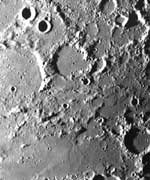Monday, January 24 – Up early? Great! Then let’s start the week off on authoritative note as Mars will be officially declared to have reached magnitude 1. As we’ve watched its return, the gain in brightness has us ready to once again begin viewing and looking forward to opposition at the beginning of November.
The Moon will dominate the evening skies tonight, but there are myriad delights to be explored on the lunar surface despite its brightness. It’s a fantastic opportunity to discover the bright rays of Tycho and explore “splashy” areas like Copernicus, Aristarchus and Keplar. How far can you trace the rays? Can you see the long ray that cuts across Mare Serentatis? Notice the crater rim of Plato to the north, how does it compare to Grimaldi in the west? For those with filters, enjoy looking for the bright rings of craters Dionysius and Pytheas. No filter? No problem! Although this might sound a bit strange, try wearing a pair of polarized sunglasses while viewing – you’d be surprised!
Only five degrees south of our “phat” Moon tonight, you will find the “Lord of the Rings” – Saturn. With the whole world buzzing about the excitement of the successful Huygens landing, why not invite family or friends to view with you? Titan is easily visible in even small scopes and it’s a wonderful opportunity to spark a child’s imagination!
Tuesday, January 25 – The Moon reaches Full this morning at 5:32 a.m. EST. Tonight it will rise within minutes of sunset and its majestic form at this time of year has long been captured in folklore. Known by many names, such as the Cold Moon, Winter Moon, Quiet Moon or Snow Moon, it is certainly an inspiring sight against the backdrop of the diamond bright stars of winter. Tonight let us visit the most brilliant star of all – Sirius.
Also known as the “Scorching One”, Alpha Canis Majoris is the brightest of the fixed stars at an amazing -1.42. With the exception of Alpha Centauri, Sirius is the closest of all the stars that we can see unaided at only 8.7 light years away – but it’s not standing still. As part of the Ursa Major Stream of moving stars, it has changed its position by one and half times the apparent width of the Moon in just 2000 years!
In the telescope, this main sequence star is a dazzling white tinged with blue. But thanks to our atmosphere, Sirius’ light will produce all the colors of the rainbow as it sparkles in our eyes. For many of us this beautiful iridescence is all we will ever see of Sirius, but for those with 10″ and larger telescopes a perfectly steady sky will reveal Alpha Canis Majoris’ secret – a white dwarf companion! Although this 8.5 magnitude star is well within the range of even small scopes, the blinding glare of the primary makes it a very elusive target. In another 20 years it will have reached its maximum separation of 11.5″, but keep a watch to the southeast as you view the “Scorching One” tonight – perhaps you’ll spot Sirius B!
Wednesday, January 26 – With just a small margin of time tonight to explore before the Moon rises, why not try your hand at a less popular Messier object? The M79 is located in the southern constellation of Lepus and it’s quite easy to find! Beta and Epsilon are the two southernmost stars, below them and forming a shallow “triangle” is a slightly dimmer star. Holding your hand at arms length, the M79 is two finger-widths away to the northeast.
Originally discovered by Mechain in October of 1780, Charles himself didn’t get around to looking at one of the very few globular clusters of winter until December of that year. On a good night, this small “round fuzzy” can be spotted with binoculars, but truly takes a telescope to appreciate. Moving away from us at 188 miles per second, the 8th magnitude M79 will show as a concentrated ball of unresolvable stars to small aperture and begin resolution with larger scopes. At around 42 light years away, this often over-looked Messier object is one of the very few globular cluster that resides further out in Milky Way galaxy than our own solar system!
If you need a winter smile, then wait about 3 hours after sunset tonight to check out the constellation of Leo – the “Lion” is taking a bite out of the Moon! Note the faint crown of stars about a hand span to the upper left of Luna. This is the “head” – while bright Regulus to the lower left is the “heart”. The figure becomes complete as the triangle of stars to the east represents the great “Lion’s” haunches.
Thursday, January 27 – Although the Moon will rise quite early tonight, open clusters make a fine target, so let’s head out toward Gemini and discover yet another Messier object that contains “more than meets the eye” – M35!
Cataloged by Messier in 1764, the M35 is easily found by locating Eta Geminorium and moving just slightly more than two finger-widths to the northwest. Best appreciated at lowest power, this very “open” cluster contains many different spectral types and magnitudes that are visible even in binoculars. At around 2200 light years away, large aperture telescopes at minimal magnification will pick up on an additional bonus on the cluster’s southwest edge. The NGC 2158 is about six times more distant than the M35. This very concentrated galactic cluster is roughly 8 million years old, making the trip to the M35 a dual delight!
If you’d like proof that the “Lion” had the Moon in its mouth yesterday, have look at the lunar surface tonight with a telescope or binoculars. Just north of the terminator’s mid-point you will see the very last remnants of the west wall of Mare Crisium – looking very much like a “bite” taken out of the lunar edge!
Friday, January 28 – And speaking of lunar geography, today Johannes Hevelius was born in 1611. So what, you say? Then think on this… Hevelius was using a telescope to view the Moon’s surface and produced the very first detailed maps which were published as “Selenographia” in 1647. That’s 358 years ago! The Polish astronomer then went on to name a constellation that still remains in use today – Lynx. When asked to explain how he came up with the name, he said that an observer needed to have eyes like a lynx just to see it!
Tonight let us celebrate Hevelius’ achievements by putting on our “cat’s eyes” as we go in search of one of the most distant objects in our galaxy – the NGC 2419. As a telescopic object only, this magnitude 11.5 study requires clear dark skies and at least 150mm of aperture. Since Lynx is a difficult constellation, you will find this easier by going 7 degrees north of Castor. You will know if you have the correct field if two stars appear to the western edge of a hazy patch. There is a very good reason “why” this elusive globular cluster is so special!
Most commonly known as “the Intergalactic Wanderer”, the NGC 2419 is so distant that it was at one time believed to actually be outside our own galaxy. Almost all globular clusters are found within our galactic “halo” – a region which exists about 65,000 light years around the galactic center. Our faint friend here is at least 210,000 light years from where it should be! When I tell you it’s out there… I’m not kidding. The NGC 2419 is as distant as our galactic “neighbors”, the Magellanic Clouds! But don’t worry, our galaxy has sufficient gravitation to keep “the Intergalactic Wanderer” around long enough for you to capture it for yourself!
Saturday, January 29 – While the Moon is absent from our early evening sky, take the time to simply go out and look up! The Winter Milky Way is a very glorious sight, with the Perseus and Orion spiral arms stretched overhead from the northwest to southeast. How could you not want to explore?! Tonight let’s aim binoculars and telescopes at one of the finest areas in our galaxy – the “Great Orion Nebula”.
One could devote years to studying just this region of the sky, as I could devote thousands upon thousands of words to tell you of its structure and beauty. Around 1600 light years away from us, this huge glowing cloud of “star stuff” is mainly florescence fueled by the extreme temperatures and ultra-violet radiation coming from its heart – Theta Orionis. Even small binoculars can see this “furnace” of four stars, but we will explore their intricacies at a later time. Tonight I would rather you just relax and note all delicate structure embedded in this grand nebula. For telescopes to truly grasp the vastness of this region, turn off your drives and allow it to flow gently past your gaze as you watch filaments, ribbons and encased stars sail past. For large telescopes, there is no more glorious sight than the fine streamers and slender threads which extend well beyond the bright parameters. There are loops, curls and swirls to be examined and the more aperture you have – the grander it becomes. If you sense this is an area of great turbulence, like frozen smoke, you would be correct. There are widely varied radial velocities throughout the structure!
Just relax and enjoy… It’s the finest in the night sky.
Sunday, January 30 – In the very early morning hours, the Moon will occult bright star Eta Viriginis for the biggest majority of Canada and the United States. See IOTA for times and locations. (I caution you this is right on the dividing line of time and date, so please make suitable adjustments for your specific locale.)
With a considerable amount of time before the Moon rises tonight, let’s bundle up in parkas and snow boots as we head for a namesake planetary nebula so fitting for this time of year – “The Eskimo”!
Fairly easily found by locating Wasat – Delta Geminorum – at the “waist” of Gemini, use the finderscope to locate wide double, 63 Geminorum to the east. You will find the NGC 2392 is only 2/3 of a degree southeast. Easily distinguished in even small telescopes as a blue/green “disc”, this colorful planetary nebula is around 3000 light years from us and requires large aperture to truly appreciate. At high power the 10th magnitude central star is very apparent and some of the “features” seen in photographs can be caught. While our eyes can never resolve the “Eskimo” in the same fashion that CCD imaging can, it is still possible to see the faint halo that surrounds the inner nebulosity, appearing much as a “parka-like hood” around a human face. Who knows? If we stay out in the cold long enough, we might even see “polar” bears rising in the northeast! Welcome back, Ursa Major…
And if you are out late enough to see the Moon rise in the northern hemisphere, have a look for Jupiter about 2 degrees to Luna’s lower left. If you were to watch all night, you would see the Moon cruise along just below the “Mighty Jove’s” position. By the time that dawn begins to stain the eastern sky, you will see the two ecliptic “dance partners” have now switched positions as the Moon is now 2 degrees to the lower left of Jupiter!
Until next week? Stay warm while you’re observing. We might be looking at the Moon, but we’re still reaching for those far away stars! Light speed… ~Tammy Plotner


